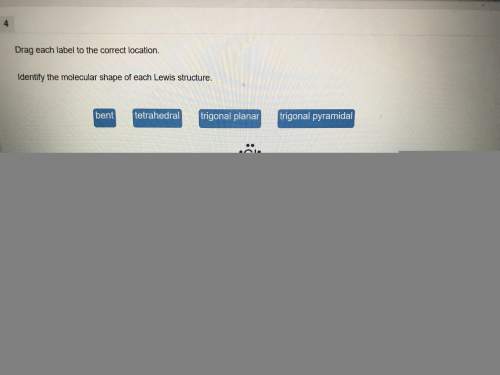
The dissociation of molecular iodine into iodine atoms is represented as i2(g) ⇌ 2i(g) at 1000 k, the equilibrium constant kc for the reaction is 3.80 × 10−5. suppose you start with 0.0456 mol of i2 in a 2.28−l flask at 1000 k. what are the concentrations of the gases at equilibrium? what is the equilibrium concentration of i2

Answers: 3


Another question on Chemistry

Chemistry, 21.06.2019 16:50
If a substance is not at its melting or boiling point, as the heat content of a sample of matter increases, its temperature increases the number of intermolecular bonds decreases the space between particles increases the particles move faster
Answers: 2

Chemistry, 22.06.2019 01:30
Reaction rate depends on how many molecules are coming into contact with each other with enough energy to react. increasing the temperature of the reactants will increase -
Answers: 3

Chemistry, 22.06.2019 01:30
100 points answer quick the table compares the number of electrons in two unknown neutral atoms. comparison of electrons atom number of electrons a 10 d 11 use this information to determine the number of valence electrons in the atoms. which of the following correctly compares the stability of the two atoms? both are unreactive. both are highly reactive. a is unreactive and d is reactive. a is reactive and d is unreactive.
Answers: 1

Chemistry, 22.06.2019 02:50
Using a value of ksp = 1.8 x 10-2 for the reaction pbcl2 pb+2(aq) + 2cl -(aq). if the value of ksp was determined to be only 1.2 x 10-2: too much solid has dissolved. additional precipitate is forming. the solution is unsaturated. the ions are now combining to reduce their concentrations.
Answers: 3
You know the right answer?
The dissociation of molecular iodine into iodine atoms is represented as i2(g) ⇌ 2i(g) at 1000 k, th...
Questions




English, 29.09.2019 11:00

English, 29.09.2019 11:00

Mathematics, 29.09.2019 11:00





Biology, 29.09.2019 11:00


Mathematics, 29.09.2019 11:00

English, 29.09.2019 11:00

Mathematics, 29.09.2019 11:00

English, 29.09.2019 11:00




![\frac{[I]^{2} }{[I_{2} ]}](/tpl/images/0472/7611/f811c.png)
 → [I₂]₀ = 0.0200 M
→ [I₂]₀ = 0.0200 M![\frac{[I]^{2} }{[I_{2} ]} = \frac{(2x)^{2} }{0.0200 - x} = 3.80x10^{-5}](/tpl/images/0472/7611/3afcc.png)




